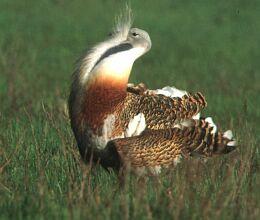Scientific classification
Kingdom: Animalia
Phylum: Chordata
Class: Aves
Order: Gruiformes
Family: Otitidae
Genus: Otis
Species: Otis tarda
Distribution and habitat
This bird's habitat is open grassland, although it can be found on undisturbed cultivation.
Great bustards can be found worldwide, though in some locations, their numbers are scarce. The world Great bustard population is estimated at 43,500–51,200 individual birds. They have undergone a long-term and marked decline, especially since early 19th century that continues virtually across entire range except in Iberia where populations are considered stabilised and west Russia where an increase in population has been reported.
Great Bustards have a patchy distribution across Eurasia, from Portugal and Spain in the west through Europe and the Russian Federation to Mongolia and China in the east. There are probably small populations in North Africa and the Middle East although their continued existence is uncertain.
Description, identification
Huge, turkey-like bird of open grassland. Both sexes have grey head and neck; chestnut back, wings and tail delicately barred with crescents of black and white. Strong, longish legs grey. In flight, most of wing white. Male, larger than female, has bold white moustaches and, by raising tail and turning wings inside-out in display, becomes obvious at great distance. Generally gregarious.
Diet and feeding
The Great bustard is omnivorous, meaning it eats both animal and plant matter. Diet is mainly plants in Spring, Autumn and Winter. Typically takes young shoots, leaves, flowers, ripe and unripe seeds but occasionally rhizomes, bulbs, berries and fruits. Proportion of animal food varies with season, locality, age and sex of bird. Mostly carnivorous in summer. Insects and their larvae predominate but small vertebrates such as voles and lizards also taken.
Behaviour
Great bustards are highly gregarious birds that form social units termed ‘droves’. Males and females live in separate droves and there is a tendency for birds of the same age to keep together. Large, often loose, flocks form in winter, which may wander in search of food, sometimes joining up with other flocks. Female droves visit groups of displaying males briefly during the breeding season.
It has a stately slow walk, and tends to run when disturbed rather than fly. It is gregarious, especially in winter.
Breeding
Before mating, the males moult into their breeding plumage around January. Like other bustards, the male Great Bustard has a flamboyant display showing much white, mainly from the undertail, and withdrawing the head. The Great Bustard breeds in March, and a single male may mate with up to 5 females. All breeding Great Bustards also moult again from June to September.
Two or three olive or tan coloured, glossy eggs are laid in a small ground scrape. Eggs weigh about 150 g (5.3 oz) and are on average 79.4 mm (3.1 in) tall by 56.8 mm (2.2 in) wide. The female incubates the eggs alone for around 4 weeks. The chicks almost immediately leave the nest after they hatch, although they do not move very far from their mother until they are at least 1 year old. Young Great Bustards begin developing their adult plumage at about 2 months, and begin to develop flying skills at the same time. They practice by stretching, running, flapping, and making small hops and jumps to get airborne. By three months they are able to fly reasonable distances.
Part of the ecosystem
It occurs in open, flat or somewhat rolling landscapes, usually with a mixture of steppic grassland, crops (cereals, oilseeds, fodder plants) and bare ground. Areas with little or no disturbance and abundant supply of insects are required for successful breeding.
Endangered species
The Great Bustard is named in the Hungarian Red Data Book of endangered species list. In 1970 became a protected bird, since it can not be hunted. Who shoot a bird will pay dearly for it, as the bird is in the highest conservation value category with a 1 million HUF fine.
John Gooders: Field guide to the birds of Britain & Europe, (Illustrated by Alan Harris), Kingfisher Books
http://www.birdlife.org/datazone/speciesfactsheet.php?id=2760
http://greatbustard.org/about-the-birds
http://www.debrecensun.hu/news/Great_bustard_population/671/
